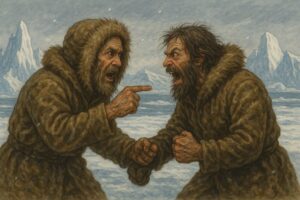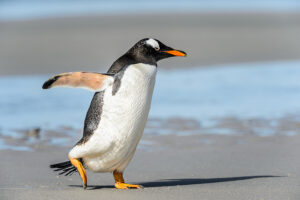Imagine the cold, icy, punishing environs of Antarctica. Now imagine that same thing, but covering our entire planet from Pole to Pole. Scientists call it Snowball Earth, and it’s happened at least three times.
How would you survive such inhospitable conditions?
Well, if you were an animal living 720 million years ago, you might do so by clinging to the underside of sea ice and living off microorganisms, just as modern sea anemones in Antarctica do.

An underwater scene near Antarctica. The simplicity of life on display might be a reflection of life on Snowball Earth 720 million years ago. Photo: Shutterstock
That’s the theory behind Animal survival strategies in Neoproterozoic ice worlds, a recent paper by Huw Griffiths, Rowan Whittle, and Emily Mitchell. In it, the scientists argue that observing the survival strategies of modern marine animals in extreme environments like Antarctica can provide a window into the distant past.
Such a window is crucial because if there’s one thing colossal ice sheets are good at, it’s grinding up traces of animal life, leaving no chance for fossilization.
“It’s basically like having a giant bulldozer,” Huw Griffiths, a scientist at the British Antarctic Survey and lead author of the paper, told Hakai Magazine. “The next glacial expansion would have just erased [all traces of life] and turned it into mush, basically.”
Keep it simple, stupid
According to the paper, there have been at least three instances of Snowball Earth, with the earliest occurrence dating back to almost 720 million years ago. That time, the icy conditions lasted a whopping 60 million years, a long time for animals to thrive on such a cold planet.
So how did they do it?
Well, they almost certainly lived underwater and survived on the microorganisms that inhabit the underside of sea ice, just as modern krill do. They also adopted a strategy of remaining very, very simple — complexity was not a winning strategy on Snowball Earth.
“We are really talking about very basic forms of life…but at the time that’s all you’d have needed to be king of the animals,” Griffiths said to Hakai Magazine.
All hail the ancient sponge. King of the sea.

An illustration from Animal survival strategies in Neoproterozoic ice worlds reconstructs what life might have looked like under ice shelves and sea ice. The inset images are modern-day analogs: sponges, anemones, and algae. Illustration: Franz Anthony
Snowball Earth: If you can make it there, you’ll make it anywhere
Conditions on Snowball Earth were low on oxygen, including in the water. But in present-day Antarctica’s surrounding ocean, deep water is oxygenated via sinking surface water as a natural result of ice formation. Scientists believe the same thing happened on Snowball Earth.
Result (in theory): oxygen-loving animals on Snowball Earth could thrive in safety far below the icy surface.
On top of that, one of the three instances of Snowball Earth was more like Slushball Earth, and the comparatively warmer conditions might have allowed for frequent melt/freeze cycles. Researchers observing similar cycles in modern Antarctica have noted that the advance and retreat of ice shelves seeds algae and other simple plant life in otherwise barren zones.
According to Griffiths et al., the same thing might have happened on Slushball Earth, providing both much-needed food and oxygen for the simple organisms trying to scrape by.
What does all this mean for us modern, decidedly un-snowballed animals?
Well, the more scientists understand how life existed on Snowball Earth, the more they might come to understand the potential for life elsewhere.
“The recent glacial cycle has driven the evolution of Antarctica’s unique fauna by acting as a ‘diversity pump,’ and the same could be true for the late Proterozoic and the evolution of animal life on Earth, and the existence of life elsewhere in the universe on icy worlds or moons,” the authors conclude.
Exciting stuff, particularly as we prepare to take the first real steps beyond our moon and into our solar system. Who knows what we might find?*
*Editor’s note: It’s probably going to be a sponge.






